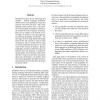Free Online Productivity Tools
i2Speak
i2Symbol
i2OCR
iTex2Img
iWeb2Print
iWeb2Shot
i2Type
iPdf2Split
iPdf2Merge
i2Bopomofo
i2Arabic
i2Style
i2Image
i2PDF
iLatex2Rtf
Sci2ools
EACL
2010
ACL Anthology
2010
ACL Anthology
Generating Approximate Geographic Descriptions
Georeferenced data sets are often large and complex. Natural Language Generation (NLG) systems are beginning to emerge that generate texts from such data. One of the challenges these systems face is the generation of geographic descriptions referring to the location of events or patterns in the data. Based on our studies in the domain of meteorology we present a two staged approach to generating geographic descriptions. The first stage involves using domain knowledge based on the task context to select a frame of reference, and the second involves using constraints imposed by the end user to select values within a frame of reference. Because geographic concepts are inherently vague our approach does not guarantee a distinguishing description. Our evaluation studies show that NLG systems, because they can analyse input data exhaustively, can produce more fine-grained geographic descriptions that are more useful to end users than those generated by human experts.
EACL 2010 | End Users | Geographic Descriptions | Natural Language Generation | Natural Language Processing |
| Added | 29 Oct 2010 |
| Updated | 29 Oct 2010 |
| Type | Conference |
| Year | 2010 |
| Where | EACL |
| Authors | Ross Turner, Somayajulu Sripada, Ehud Reiter |
Comments (0)

